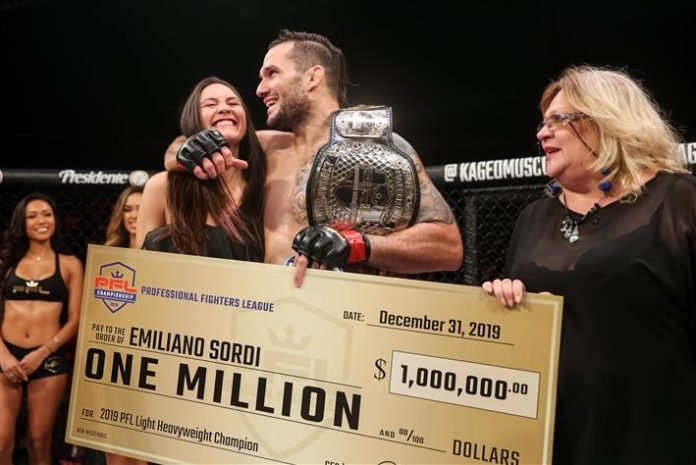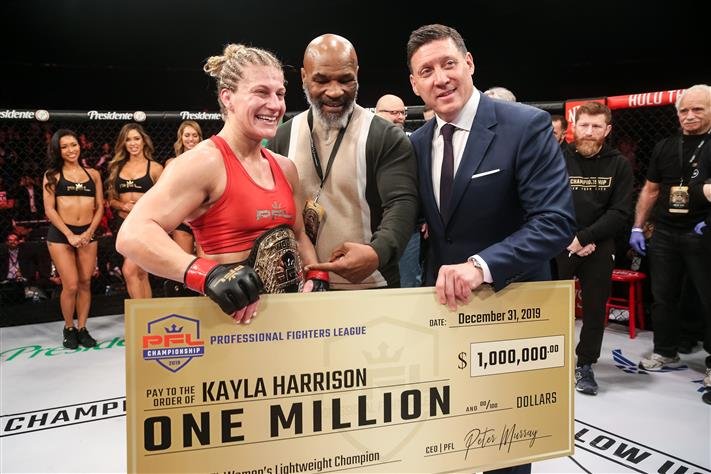
Fighter Compensation is a frequent topic of debate in MMA. How much guaranteed money would it take for you to take a professional mixed martial arts fight? What is the amount of money that it would take to get you to risk your pride and health in front of peers, family, and fans?
6 figures? 7 figures?
The PFL’s million-dollar tournament ended on December 31st and they just might be on to something.
Far more often than not, the show money, or money that fighters are paid to show up in the cage for their fights, is much less than that. In most major MMA promotions, fighters are paid show money to make weight and enter the cage on fight night, but after that, nothing is guaranteed. Often the win money, that is given to the fighter that earns the victory, is around the same amount as the show money. But the loser frequently goes home with nothing else.
Major professional mixed martial arts promotions such as the UFC, Bellator, ONE FC, RIZIN, and the PFL all pay their fighters based on their star power. But just how much of a discrepancy is there between the amount of money a fighter makes based on promotion and their spot on the card? Star power and talent inside the cage are not the same things, and at the end of the day even though it’s the entertainment business, fighters should be rewarded for winning fights and not punished because they don’t have an exciting style or can’t generate hype because of their lack of antics outside of the cage.
Many professional martial arts promotions give out bonuses based on performance, but often the money pool is small and that alone can not be relied upon as a source of guaranteed money. Being in the Fight of the Night and coming out with a bonus is possible, but not every fight can be Fight of the Night.
Sponsorships from companies outside of MMA promotions are another income source, but many average tier fighters simply cannot rely on sponsorships as their main sources of income. And as we have seen in recent years in the UFC, promotions don’t always allow fighters to have whatever outside sponsors they’d like to generate income. While medical bills are sometimes paid for by fight promotions, many fans would be surprised by just how little some fighters walk away with after everything is all said and done. With other factors like paying your team/trainers/sparring partners and being out of work depending on the amount of damage that was taken in a bout, it can be extremely difficult for even some well-known fighters to make a comfortable living.
PFL Lightweight Bracket update at #PFL9 in Long Beach. #PFLPlayoffs #FightTwice #WinTwice #LA #MMA @NatanSchulte @NBCSN @CWadeMMA @TavaresMMA @RashidGorets pic.twitter.com/N8RVu4Ooqi
— PFL (@PFLMMA) October 14, 2018
Promotions like the Professional Fighters League and Bellator are truly changing the game. Their revival of the tournament-style format that MMA began with is not only a breath of fresh air, but also offers much more incentive and reward for many fighters.
Specifically, let’s focus on the PFL, with their tournament and season-based format that determines every champion at every weight class. With every champion winning the same amount of money (unlike Bellator, or any other major promotion for that matter). The PFL also has far fewer fighters on their roster, so each fighter is able to be compensated more fairly. Every fight during the year is part of a season and all of the fighters are jostling for a high ranking in the year-end million dollar tournament.
Even though many fans would hop in the cage for a guaranteed forty grand, that is almost unrealistic with some athletes. Every fight has a winner and a loser so having half of your check withheld just because you came out on the wrong side of a hard-fought split decision can be a brutal pill to swallow. What’s worse is that after many fights, fighters are required to go on mandatory medical suspension if they suffered severe enough injuries. This is good for fighter safety, but during this time fighters are not able to actually earn a living doing what they do.

Having a season and playoffs with a spread-out tournament not only offers something fresh, exciting and an easy to grasp concept for fans, but it also gives fighters more incentive to come out and fight as hard as they can — because their efforts will immediately be rewarded, and they have a shot at a lot more money. Fighters don’t have to worry about getting a fight with this guy or that guy, and all the politics that fans often hate. As a fighter, if you win, you get a better seat in the tournament. With a better seat in the tournament, a better chance to go farther and if you go farther in the year-end tournament you make more money.
With that incentive, the PFL seems to be on to something that has struck a chord with fighters. You see it with what has generally been an above-average finishing rate. You see it with their ability to sign a star like Rory MacDonald. With Bellator (and South Korea’s ROAD FC) having added million dollar purses for the winner of their tournaments, it’s clear the PFL has been an influence already.





















